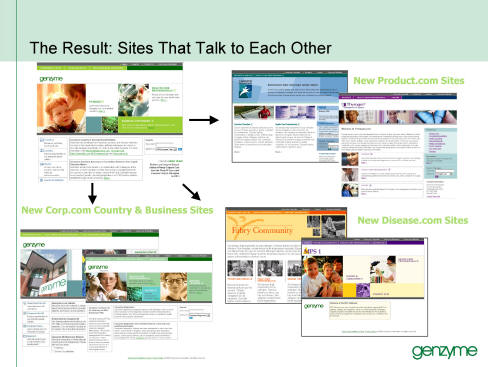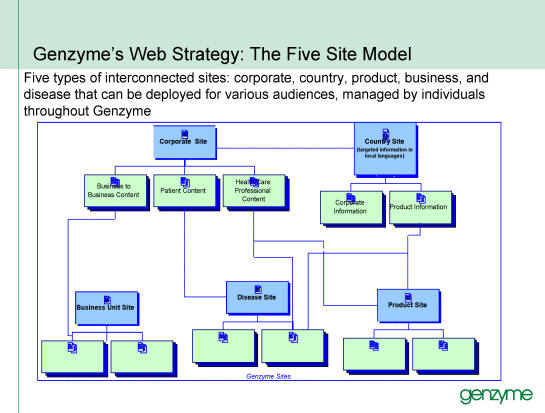 |
 |
||||||||||||||||||||||||||||||||||||||||||||||||||||||||||
|
|
|||||||||||||||||||||||||||||||||||||||||||||||||||||||||||
|
Genzyme achieves multi-million dollar return-on-investment using Stellent Universal Content Management to increase the ease and speed of creating uniform, branded Web sites Background With more than 6,300 employees serving patients in more than 30 countries worldwide, Genzyme uses the Web to communicate with patients, health care professionals and business customers. Genzyme’s Web presence goes back to 1996 with the manual posting of its annual report. From there, various inconsistent, static sites grew organically at Genzyme. These sites were difficult to update because content changes needed to be made by internal information technology (IT) staff or vendors. And although internal and external users wanted more functionality from Genzyme’s Web properties, IT and corporate communications teams had limited resources to deliver it. As a result, multiple business units and departments began to fund and create their own locally managed Web sites to meet their specific needs, which led to significant branding inconsistencies. Overall, the process for managing and operating Genzyme’s Web sites was so poor that by year 2000, marketing and product information on many of the sites was out-of-date, incorrect and “off brand.” After evaluating numerous Web content management solutions to remedy this problem, Genzyme selected Stellent® Universal Content Management in 2001 to create a multi-site management infrastructure that would permit it to cost-effectively automate the launch of at least 20 unique, “on brand” Web sites across five interconnected areas: corporate, country, product, business and disease state. Some of Genzyme’s additional objectives for its multi-site management initiative included: (1) empowering business users to create and modify their own content using a decentralized creation and maintenance environment, (2) implementing a scalable solution to meet other current and future content management needs, (3) developing the foundation for using the Internet as a tool for doing business at Genzyme, and (4) complying with increasing regulatory and legal requirements that differ from product to product and country to country.
How Genzyme’s Stellent multi-site management solution works Genzyme’s multi-site management implementation serves as the backbone of Web initiatives across its enterprise. Using a Web browser, Genzyme employees contribute Web content –– such as medical condition background information, product descriptions, clinical and research data, marketing collateral, services listings, licensing and partnering information, company news releases –– into the Stellent system, where it is saved in its native format (i.e. word processing document, spreadsheet or graphic file), enabling easy updates. Once content is submitted into Stellent Universal Content Management, the system automatically converts this content from its native format to Web-viewable formats, including PDF and HTML, and publishes it to the appropriate Genzyme Web site(s). This functionality enables both technical and non-technical users in various business units and geographies to deploy and manage their own Web sites to ensure specialized content is delivered in near real-time. Genzyme also uses Stellent to create libraries of Web site components, such as design templates, navigation, graphics and code, which are available to business units and geographies building their own sites. These common components ensure business units and geographies develop and manage their sites within corporate guidelines by allowing corporate teams to drive major site aspects, such as design and navigation structure. By June 2004, Genzyme had launched 20 separate Web sites using Stellent technology, with five more planned by year-end. In addition, Genzyme also will use Stellent to serve up selected content in Genzyme’s Plumtree-based intranet portal.
Benefits of using Stellent Universal Content Management To assess the benefits of Genzyme’s multi-site management implementation, Stellent contracted META Group, a leading IT research and consulting firm, to conduct a return-on-investment (ROI) study. To gather data, META interviewed Genzyme IT staff, corporate communications, senior management and internal users. Through the end of 2004, META estimates Genzyme’s $682,000 investment in its Stellent multi-site management project will return an anticipated ROI of $3.8 million. The benefits generating this significant ROI are outlined in 10 separate categories in the META study: Benefit 1: Reduced Printing, Paper, Copying and Shipping Costs With Genzyme’s Web sites providing 24x7 access to content, interested parties can obtain up-to-date information without Genzyme shipping them materials as it once did. META estimates each new site leads to an average cost savings of $32,500. Benefit 2: Elimination of Site Maintenance Outsourcing Costs With the use of Stellent technology, Genzyme has eliminated its Web content management outsourcing costs. Only one-half of these savings were realized during the first year in production (2002) as legacy sites were converted, but since that time, Genzyme has completely done away with $100,000 in outsourcing expenses along with editing costs. Benefit 3: Reduced Costs to Launch New Sites Prior to the Stellent deployment, it cost Genzyme approximately $100,000 and took six months to launch a new site. With Stellent, costs are down to $40,000 on average with a 12-week launch cycle. This shift equates to an average of $60,000 in savings for every new site, plus the associated benefits of faster site implementations. Benefit 4: Information Accessibility Genzyme’s global presence and the needs of its employees, partners and clients require 24x7 access to its latest content and data. The only way this accessibility is possible is via self-service sites tailored to unique audiences. Stellent enables Genzyme to provide this functionality in a stable environment that can be easily expanded to include additional audience-specific sites. Benefit 5: Reduced Compliance and Organizational Legal Risks As part of the original justification for the Stellent system, Genzyme calculated the external costs for complying with an FDA-mandated change to its legacy Web sites. The costs were anticipated to be more than $22,167 per site using the old Web site maintenance and publishing techniques. Using Stellent, Genzyme anticipated 100 percent of these external costs could be eliminated. Moreover, Genzyme can leverage Stellent’s ability to support Section 508 disability access, records management, compliance-related auditing, and privacy and security requirements for internal and external access to information if and when these functionalities are mandated by government or industry regulators. This utility will significantly reduce future anticipated costs in these areas. Benefit 6: “On Branding” of All Sites with Consistent Look and Feel The use of Stellent’s design templates, syndication features and standardized process for launching new sites allows Genzyme to realize many of its strategic goals, including the creation of a more consistent global brand, while supporting the individual brand images of Genzyme, its businesses and product groups. Previous versions of Genzyme’s legacy sites suffered from “big inconsistencies in the individual page look and feel.” While this distinction may seem trivial, the efficiency gained from publishing all of its content using fewer than 25 standard templates is significant. Moreover, since the Stellent system facilitates the separation of content and presentation elements, Genzyme can easily make minor template changes to change branding instead of manually updating individual Web pages or creating new sites to meet new guidelines. Furthermore, the separation of content and presentation allows information to be delivered to mobile or other non-standard devices that are making inroads into the health care industry (i.e. kiosks, tablet PCs). Benefit 7: Timely, Immediate and Coordinated Content Updates Given the time-sensitive nature of much of Genzyme’s content, the ability to create, modify and promote content across various sites at any time was a key strategic goal of the multi-site management system. Stellent technology provides Genzyme this flexibility. Benefit 8: Reduced Effort for Site Design, Maintenance, Administration and Recovery through Content and Site Coordination Genzyme’s multi-site requirements dictated a system that could provide strong administration capabilities. Genzyme previously had one full-time employee (FTE) administrating three legacy sites in 2000. Two FTEs are now supporting 20 unique Web sites and will be able to support all 25 planned sites. What is significant about this benefit is that Genzyme would not have been capable of implementing a multi-site approach at all had productivity increases not been realized. Benefit 9: User Ownership of Content and Its Freshness Similar to the administrative benefits realized with Stellent, the benefit of users having direct control of their content has allowed Genzyme to use its preferred multi-site approach. Prior to Stellent, Genzyme required 0.5 FTEs from corporate communications to support three sites. Current data from Genzyme shows that 2 FTEs from corporate communications are now capable of supporting 12 sites or the same ratio. However, the change allows Genzyme to maintain the sites internally instead of using outsourcers (refer to Benefit 2 above). Benefit 10: Automated Content Renditioning to HTML and PDF Formats Stellent technology provides advanced publishing capabilities that allow native documents to be rendered automatically into HTML and PDF. When evaluating the effort and associated costs to perform these tasks, META applied a conservative cost of manually performing these tasks –– $20.07 per Web page. Considering the average Web pages added or modified to a single Genzyme site is approximately 156 pages annually, this yields productivity savings of more than $3,100 per site annually. By 2004, this represents nearly $70,000 in annual savings. The “cost of doing business” related to organizational Web sites has driven increasing adoption of multi-site management tools, such as Stellent Universal Content Management, that can return content creation, approval and lifecycle management functions to business users. For Genzyme, this functionality not only has reduced IT bottlenecks and provided a consistent look and feel across its Web sites, it also has generated significant ROI and established the foundation for continued, timely communication with patients, health care professionals and business customers via the Web.
|
|

